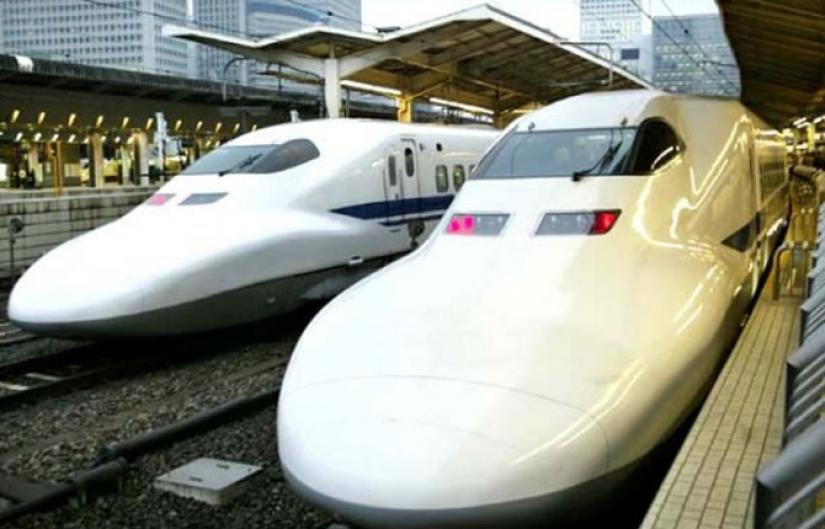 October of 1964 marked the age of Japan's bullet train era, as Tokyo saw a sleek blue trail glide through its urban sprawl.
October of 1964 marked the age of Japan's bullet train era, as Tokyo saw a sleek blue trail glide through its urban sprawl.
It was the defining symbol of the country's astounding recovery from World War II. With the hosting of the 1964 Tokyo Olympic Games, this technological phenomenon marked the Japan's return to the forefront of the international community.
In the 55 years since that first train, the word Shinkansen -- meaning "new trunk line" -- has become an internationally recognized byword for speed, travel efficiency and modernity.
Japan remains a world leader in rail technology. Powerful conglomerates such as Hitachi and Toshiba export billions of dollars worth of trains and equipment all over the world every year.
The Shinkansen network has expanded steadily since the 515km Tokaido line, linking Tokyo and Shin-Osaka was completed in 1964. Trains run at up to about 322km/h on routes radiating out from the capital -- heading north, south and west to cities such as Kobe, Kyoto, Hiroshima and Nagano, reports CNN.
As well as a symbol of recovery, Shinkansen have been used as a tool for Japan's continuing economic development and an agent of change in a country bound by convention and tradition.
With Japan's four main islands stretching around 2,900km from end-to-end, journeys between the main cities were long and often tortuous.
An over 16hour-journey from Tokyo to Osaka in the 1890s came down to just over 3 hours in 1965, via the Shinkansen.
Demands for a "standard gauge" rail network started in the 20th century, but it was not until the 1940s that work started in earnest as part of an ambitious Asian "loop line" project to connect Japan to Korea and Russia via tunnels under the Pacific Ocean.
Defeat in World War II meant the plans had to be shelved till the mid 1950s, with the resurgence of Japan's economy.
Japan's challenging topography and its widely varying climates, from the freezing winters of the north to the tropical humidity farther south, have made Japanese railroad engineers world leaders at finding solutions to new problems as they push the boundaries of rail technology.
While this provides arguably the defining image of the Shinkansen -- a high-tech modern train flashing past the snow-capped Mount Fuji -- it also makes the safe operation of high-speed trains much more difficult.
Despite these factors, not a single passenger has ever been killed or injured on the Shinkansen network over its 55-year history.
The next generation of bullet trains, known as ALFA-X, is currently being tested at speeds of almost 400km/h, although the service maximum will be "only" about 362km/h.
Following in Japan's tracks
In 2016-17, the Tokaido Shinkansen alone carried 159 million passengers, operating up to 13 trains per hour, carrying more than 1,300 passengers each and at frequencies more usually seen on city subway lines.
Little wonder then that many other countries have followed Japan's example and built new high-speed railroads over the last four decades.
Perhaps the best-known of these is France, which has been operating its Train à Grand Vitesse (TGV) between Paris and Lyon since 1981.
Italy, Germany, the Netherlands, Taiwan, Turkey and Saudi Arabia all now operate trains on dedicated lines linking their major cities, competing directly with airlines on domestic and international routes.
Meanwhile, India and Thailand are planning extensive high-speed rail networks to be built in the 2020s.
Even the USA, which generally favours road and air for long-distance journeys, has plans for high-speed railroads in California and Texas. Virgin Trains is planning to extend an existing route connecting Miami and West Palm Beach to link up with Orlando as well as upgrading old track to allow trains to run at the relatively high speed of about 177km/h.
Using technology initially harvested from Japan and Western Europe, and subsequently developed by its increasingly sophisticated railroad industry, China also has quickly made itself a leading player in high-speed rail.
Japan's rail legacy moving forward
"The Shinkansen is clearly much more than a means of transportation," says British academic Christopher P Hood, author of "Shinkansen: From Bullet Train to Symbol of Modern Japan."
"It was the most potent symbol of Japan's postwar reconstruction and emerging industrial might and as it continues to evolve is likely to be so for many years to come."
As Tokyo prepares to host the Olympics again in 2020, it's difficult to imagine Japan without its bullet trains.
Although the iconic blue and white 0-Series trains of 1964 are long since retired, they still form many people's image of what a bullet train looks like.
Their remarkable descendants are an indispensable part of the transport infrastructure in Japan and many other countries around the world and, as environmental concerns start to make people think twice about flying, they could be about to experience a further resurgence, prompting a new golden age for the railroad.
 Journey
Journey
41250 hour(s) 4 minute(s) ago ;
Noon 12:59 ; Tuesday ; Jul 01, 2025
How Japanese bullet trains changed the world of rail travel
Send
Bangla Tribune Desk
Published : 17:08, Nov 29, 2019 | Updated : 17:13, Nov 29, 2019
Published : 17:08, Nov 29, 2019 | Updated : 17:13, Nov 29, 2019
0 ...0 ...
/pdn/
Topics: Top Stories
- KOICA donates medical supplies to BSMMU
- 5 more flights to take back British nationals to London
- Covid19: Rajarbagh, Mohammadpur worst affected
- Momen joins UN solidarity song over COVID-19 combat
- Covid-19: OIC to hold special meeting
- WFP begins food distribution in Cox’s Bazar
- WFP begins food distribution in Cox’s Bazar
- 290 return home to Australia
- Third charter flight for US citizens to return home
- Dhaka proposes to postpone D8 Summit
- Covid19: Dhaka urges D8 to activate health programme
- Lankan Muslims annoyed over decision on cremation of dead bodies
- Nuclear bomb cannot wipe out virus
- ICC, WHO launch survey to improve COVID-19 information flows
- Beijing ready to send medical team to help Dhaka
- US citizens return home with second charter flight
- US citizens return home with second charter flight
- Trafficking survivors struggle as virus halts businesses
- 'Next two weeks crucial for Bangladesh's coronavirus fight'
- India doctors fight virus with raincoats, helmets
Unauthorized use of news, image, information, etc published by Bangla Tribune is punishable by copyright law. Appropriate legal steps will be taken by the management against any person or body that infringes those laws.
Bangla Tribune is one of the most revered online newspapers in Bangladesh, due to its reputation of neutral coverage and incisive analysis.
F R Tower, 8/C Panthapath, Shukrabad, Dhaka-1207 | Phone: 58151324; 58151326, Fax: 58151329 | Mob: 01730794527, 01730794528


